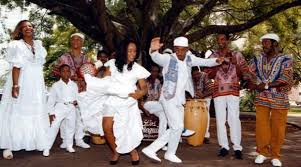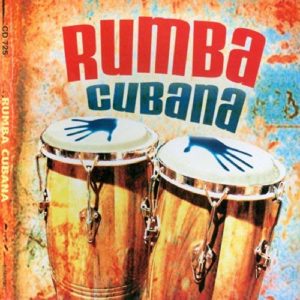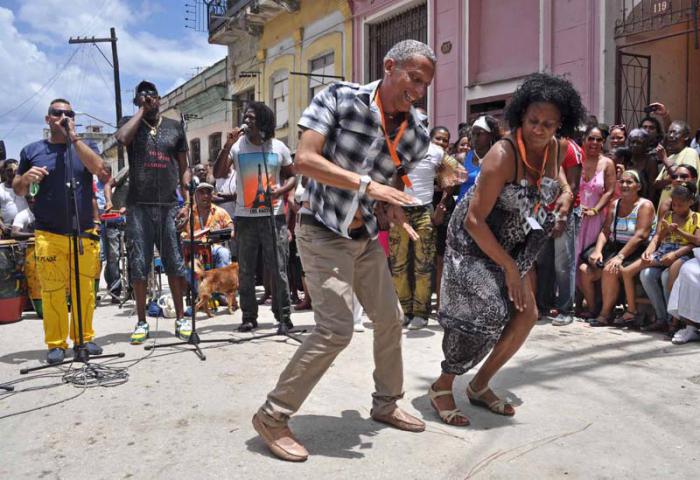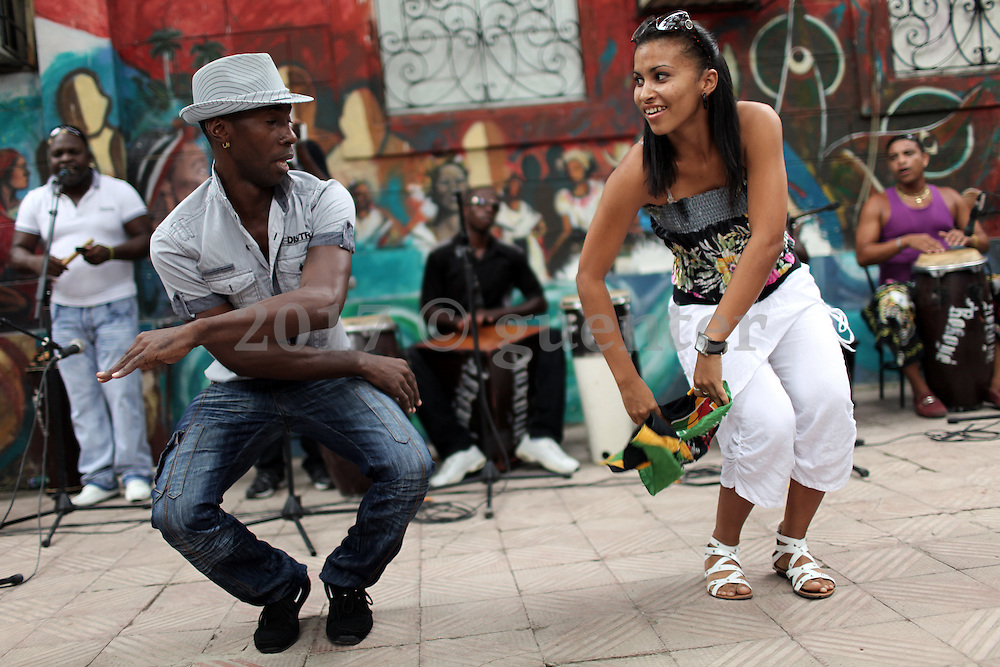The rumba was born in the sugar plantations, in the barracks of black slaves in Cuba. And although he traveled to the great dance halls in Europe, his essence is preserved in the blood of the Cubans, who, when they walk, are dancing.
Considered intangible cultural heritage of humanity by Unesco since 2016, every year the inhabitants of Havana take the streets to celebrate it, to the rhythm of the key -an instrument in which a hollow wood is struck-, the drums and songs.
“It is an expression of the exaltation of life, created during the period of slavery in sugar plantations, in neighborhoods, in ports, on railway lines,” explains Miguel Barnet.
Elegance of the Rumba.
The man moves with elegance, wears a hat, sometimes a cane, almost always goes white. The woman wears a wide flight skirt of bright color that moves along with her steps. The man gallants and persecutes the woman. Both move their hips and slide their arms and legs to the rhythm of the “tac, tac … tac, tac, tac” that marks the key, while the African drums flood the space and invite the viewer to want to dance too. Among happy movements, the gentleman performs the “vaccinao”, a movement of the pelvis that reminds us that this is also a fertility dance, and that it came from Africa.
Watching a rumba in the current Cuba, some adolescent passes with a speaker listening to reguetón, a rhythm to which, for the musical critic Pedro de La Hoz, if the electronic part is removed, the influence of the Bantu culture is found, a of the African roots of the rumba.
How the Rumba Was Born
“The rumba was born before the Cuban nation and long before the concept of homeland was born, the rumba is earlier, contributed to the development of the concept of nation, it is a fundamental element of Cuba’s identity,” says Barnet.
Reproduced by the people, it began to be practiced in the neighborhoods and communities. “It is a folklore not stopped in time, contributions and ways of doing things are incorporated, and that is still alive”, explains De la Hoz.
Then it radiates to the whole world. In the sauce, in the cabaret show, in the ballroom dancing.
“It’s music and dance that fuses the African, Spanish and other Caribbean legacies in Cuban music, it has African drums, intonations, but it has a lot of Spain, or is it that there are no traces of flamenco in the rumba? ? “, interpellates.
Now there is rumba in New York, in Paris, in Mexico, in the cinema but also in the lots. “There is rumba in the great symphonic genres but there is still rumba in the neighborhood, where it will never cease to exist,” he adds.
After arriving in Cuba or Brazil, “the Africans became aware of being part of a continent, of a greater culture, and it is returned through these songs and dances,” he explains.
And in Cuba, professionalization has taken place. This is what Isaias Rojas, from the Higher Institute of Art, sees. “It’s proven that the rumba has a unique flavor and that’s why it’s transcended, we’ve seen phenomenal rumba dancers in the United States and Eastern Europe,” he says. But the root is in the Caribbean.
“The rumba is in the daily life of man, when he goes to the cellar, to the butcher shop, since you walk, your body is talking and dancing rumba,” he concludes.
La rumba nació en las plantaciones de azúcar, en las barracas de esclavos negros en Cuba. Y aunque viajó hasta los grandes salones de baile en Europa, su esencia se conserva en la sangre de los cubanos, que, cuando caminan, la están bailando.
Considerada patrimonio cultural inmaterial de la humanidad por la Unesco desde 2016, cada año los habaneros toman las calles para celebrarla, al ritmo de la clave -instrumento en el que se golpea un madero hueco-, los tambores y cantos.
“Es una expresión de la exaltación de la vida, creada durante el período de la esclavitud en las plantaciones azucareras, en los barrios, en los puertos, en las líneas de ferrocarril”, explica Miguel Barnet.
Elegancia de la Rumba.
El hombre se desplaza con elegancia, lleva sombrero, a veces un bastón, casi siempre va de blanco. La mujer viste una falda de vuelo ancho de color vivo que se agita junto con sus pasos. El hombre galantea y persigue a la mujer. Ambos mueven las caderas y deslizan los brazos y piernas, al ritmo del “tac,tac… tac,tac,tac” que marca la clave, mientras los tambores africanos inundan el espacio e invitan al espectador a querer bailar también. Entre movimientos alegres, el caballero realiza el “vacunao”, un movimiento de la pelvis que recuerda que este también es un baile de fertilidad, y que así vino desde África.
Observando una rumba en la Cuba actual algún adolescente pasa con un parlante escuchando reguetón, un ritmo al que, para el crítico musical Pedro de La Hoz, si se le retira toda la parte electrónica, se le encuentra la influencia de la cultura bantú, una de las raíces africanas de la rumba.
Cómo Nació la Rumba.
“Nació la rumba antes de la nación cubana y mucho antes que naciera el concepto de patria. La rumba es anterior, contribuyó a que se desarrollara el concepto de nación. Es un elemento fundamental de la identidad de Cuba”, dice Barnet.
Reproducida por el pueblo, empezó a ser practicada en los barrios y comunidades. “Es un folclor no detenido en el tiempo. Se incorporan aportes y modos de hacer, y eso se mantiene vivo”, explica De la Hoz.
Luego irradia al mundo entero. En la salsa, en el espectáculo de cabaret, en los bailes de salón.
“Es música y danza que fusiona los legados africanos, españoles y de otras zonas del Caribe en la música cubana. Tiene de África los tambores, entonaciones, pero tiene mucho de España. ¿O es que acaso en la rumba no hay huellas del flamenco?”, interpela.
Ahora hay rumba en Nueva York, en París, en México, en el cine pero también en los solares. “Hay rumba en los grandes géneros sinfónicos pero sigue habiendo rumba en el barrio, donde nunca va a dejar de existir”, agrega.
Tras su llegada a Cuba o a Brasil, “los africanos tomaron conciencia de ser parte de un continente, de una cultura mayor, y ella se devuelve a través de estos cantos y bailes”, explica.
Y en Cuba se ha llevado hasta la profesionalización. Así lo ve el maestro Isaías Rojas, del Instituto Superior de Arte. “Está comprobado que la rumba tiene un sabor único y por eso ha trascendido. Hemos visto bailadores de rumba fenomenales en Estados Unidos y Europa del Este, inclusive”, dice. Pero la raíz está en el Caribe.
“La rumba está en la vida cotidiana del hombre, cuando va a la bodega, a la carnicería. Desde que tu caminas, tu cuerpo está conversando y bailando rumba”, concluye.
Agencies/El Heraldo/ Internet Photos/ YouTube/ Extractor/ Arnoldo Varona/ TheCubanhistory.com
THE CUBAN HISTORY, HOLLYWOOD.











